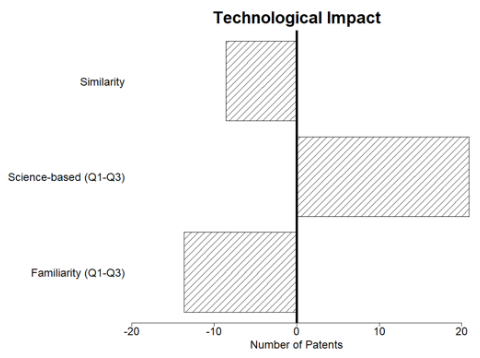The diffusion of novel ideas is in itself an important source of innovation when their adoption by others instigates improvements to the initial idea and/or identifies new applications. Rosenberg (1982), Dosi (1991), and Hall (2004), among others, have emphasised that the diffusion of innovations is often accompanied by improvements to or new applications of the original innovation.
Follow-on inventions have been studied in the evolutionary economics literature (Dosi 1982), characterising their trajectories over time. Extant empirical studies have described the diffusion of a single industrial application within the community of potential adopters, like in the case of farmers adopting hybrid corn seeds in the Midwestern US (Griliches 1957). A common finding in these studies is that the diffusion process usually starts slowly, speeds up, and finally converges to a point when the diffusion process stops as the population of adopters gets exhausted or as the new idea gets abandoned in favour of other new ideas. However, not all the technologies follow the same diffusion trajectory, raising challenging questions for scholars in the innovation field. What explains the speed and extent of the follow-on inventions of a novel technology? Why does one novel technology take a long time before take-off, while others take off very quickly? Why do some novel technologies impact a large total number of follow-on inventions, while others only a few? Until now, no empirical study reconstructs the trajectories of a large pool of new ideas to explain differences across diffusion curves.
In a recent paper (Pezzoni et al. 2019), we address this challenge using a large-scale patent dataset. Specifically, (i) we identify novel technology ideas as using for the first time ever combinations of technology components, (ii) we map for each novel technology idea its diffusion curve by tracking all the follow-on inventions that re-use the same new technology idea and, (iii) we identify what the antecedents of the new idea are that affect its initial diffusion speed and the total number of follow-on inventions generated.
Interestingly, we find that the riskier types of novel technology ideas, i.e. those resulting from the recombination of dissimilar, unfamiliar, and science-based technology components, while having a larger number of follow-on inventions, require a longer time to kick-off in the initial phase of diffusion.
Identifying a novel technology and tracing novel technologies diffusion
In identifying a novel technology, we rely on an idea widely rooted in the innovation literature according to which the creation of a novel technology is the result of recombination of pre-existing technological components (Arthur 2009, Fleming 2001, Verhoeven et al. 2016). To operationalise the novelty measure, we use patent data and we consider the patent classification codes used at the European Patent Office (EPO IPC codes) as proxies for the pre-existing technological components. We define a novel technology as the first ever appearance of a combination of two codes in a patent.
As an example, consider the “transgenic mammal technology” patent protecting the so-called onco-mouse invention, a genetically modified mouse likely to mature cancer and largely used in labs to develop oncological treatments. The ‘onco-mouse’ patent combines together, for the first time, the two IPC codes corresponding to the technological classes “Gene isolation” and “Injection of material into animals”.
Having identified the first-time appearance of a novel technology embedded in a patented invention, we trace the diffusion of the novel technology in follow-on inventions, by identifying all later patented inventions re-using the same combination of IPC codes introduced by the initial invention. After the initial 1985 onco-mouse patent, more than 200 follow-on patents re-used the same technology. These patents protected the inventions of other transgenic mammals likely to develop a variety of diseases from Alzheimer to cystic fibrosis (Murray 2010). For instance, the “diabetic mouse” was created in 1996 at the Seoul National University and is part of the diffusion curve of the transgenic mammal technology.
In our sample of EPO patents, we identify 10,782 novel technologies that generated 249,103 distinct follow-on patents. Figure 1 shows the estimated diffusion curves. The black line in the figure identifies the transgenic mammal technology.
Figure 1 Novel technologies' estimated diffusion curves
Note: sample of 10,782 successful novel technologies identified on all the patents filed to the European Patent Office in the period 1985-2015.
To estimate the diffusion curves of the novel technologies, we fitted to the actual cumulated number of inventions a Sigmoid curve. This allows us to capture the diffusion curve in two crucial parameters: the time needed to reach an initial level of diffusion, which we fix at 10% and call “legitimation time”; and the total, ceiling, number of follow-on inventions that a novel technology generates, which we call “technological impact”. On average, a novel technology in our sample takes about 6 years to legitimation and reaches its ceiling at 67 follow-on inventions. But there is substantial heterogeneity, with legitimation taking up to 17 years and ceilings up to 1000 follow-on inventions. Our onco-mouse example has a longer than average legitimation time of 8 years, but generated a much higher than average total of 267 follow-on inventions.
Determinants of the diffusion curve of novel technologies
Taking advantage of observing a large set of technologies, we look at the antecedent characteristics of the novel technologies as predictors of the different technological trajectories, as reflected in their legitimation time and technological impact. We use the characteristics of the technological components combined for the first time in the novel technology as critical features affecting the diffusion of the novel idea. A novel technology can result from the first time combination of technological components that are (i) similar or dissimilar to each other (measured by whether the components belong to the same IPC 3 class), (ii) familiar or unfamiliar to the community of inventors (measured by the number of previous inventions), or (iii) have a deeper science-based content (as measured by the number of scientific references made).
Our findings show that novel ideas that newly recombine similar components have a shorter legitimation time, but at the same time also a smaller technological impact. Similarly, we find that newly recombining components familiar to the inventor community shorten the legitimation time at the cost of a lower technological impact. Inventors who are already familiar with the combined components face a lower risk of unexpected results, increasing the confidence in reusing the novel technology and shortening the legitimation time, while the already largely exploited components lead to a lower technological impact of the corresponding novel technology. In contrast, newly recombining science-based components leads to a longer legitimation time, but at the same time generates a higher technological impact. This is consistent with science-based knowledge needing more time to be absorbed by the community of inventors, leading to a longer legitimation time, while the general and abstract nature of the science-based knowledge assures a larger number of possible technological applications, resulting in a greater technological impact.
Our results hint at a trade-off between technological impact and legitimation for the riskier type of novel inventions, i.e. those combining dissimilar, unfamiliar, and with more science-based components. Our onco-mouse example, with its longer legitimation time and its higher technological impact than average illustrates this, as with “gene isolation” and “injection of material into animals”, it is newly recombining components that are dissimilar, unfamiliar, and science-based.
Figure 2 shows the overall variation in novel technology legitimation time and technological impact when changing the values of the technological component characteristics. Specifically, we show the effect on legitimation time and technological impact of combining similar components (compared to dissimilar components), of increasing the science-based content of the combined components from the first to the third quartile of the distribution, and of increasing the familiarity of the combined components from the first to the third quartile of the distribution.
Figure 2 Variation in novel technologies' legitimation time and technological impact when changing the values of the technological component characteristics
Discussion
Our findings contribute to characterising and better understanding of the follow-on diffusion trajectories of novel technologies, and have important implications for firms and policymakers. A most interesting finding is the apparent trade-off between legitimation time and technological impact. Those novel technologies with bigger technological impact seem to need a longer time before they are legitimatised. Particularly the riskier types of novel inventions, i.e. those that newly combine dissimilar, unfamiliar, and science-based components, while having a larger technological impact, require a longer legitimation time. This raises questions about whether the higher technological impact that these riskier novel inventions generate could have been reached with shorter legitimation times. What causes a longer legitimation time for bigger impact novel inventions? Can re-use be sped up for these ‘hits’? And what kind of firm strategy or policy intervention could help?
References
Arthur, W B (2009), The Nature of Technology: What It Is and How It Evolves, Simon and Schuster.
Dosi, G (1982), “Technological paradigms and technological trajectories: a suggested interpretation of the determinants and directions of technical change”, Research Policy, 11, 147–162.
Dosi, G (1991), “The research on innovation diffusion: An assessment”, in Diffusion of technologies and social behavior,179–208, Springer.
Fleming, L (2001), “Recombinant uncertainty in technological search”, Management Science, 47, 117–132.
Griliches, Z (1957), “Hybrid Corn: An Exploration in the Economics of Technological Change”, Econometrica, 25, 501.
Murray, F (2010), “The onco-mouse that roared: Hybrid exchange strategies as a source of distinction at the boundary of overlapping institutions”, American Journal of Sociology, 116 (2), 341–388.
Nelson, R R, and S G Winter (1982), An evolutionary theory of economic change, Cambridge, MA: Harvard University Press.
Pezzoni, M, R Veugelers, and F Visentin (2019), “How fast is this novel technology going to be a hit?”, CEPR Discussion Paper no. 13447.
Rosenberg, N (1982), Inside the black box: technology and economics, Cambridge University Press.
Verhoeven, D, J Bakker, and R Veugelers (2016), “Measuring technological novelty with patent-based indicators”, Research Policy, 45, 707–723.










